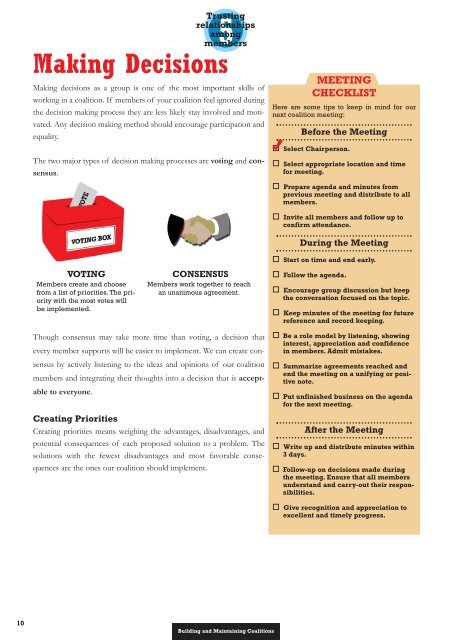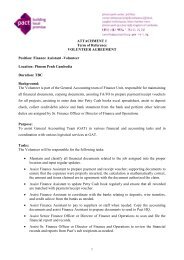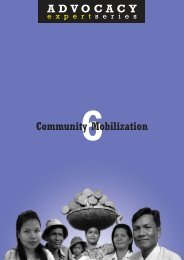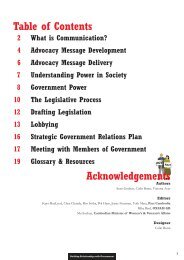Advocacy - Module 4 - English.pdf - Pact Cambodia
Advocacy - Module 4 - English.pdf - Pact Cambodia
Advocacy - Module 4 - English.pdf - Pact Cambodia
Create successful ePaper yourself
Turn your PDF publications into a flip-book with our unique Google optimized e-Paper software.
Trusting<br />
relationships<br />
5<br />
among<br />
members<br />
Making Decisions<br />
Making decisions as a group is one of the most important skills of<br />
working in a coalition. If members of your coalition feel ignored during<br />
the decision making process they are less likely stay involved and motivated.<br />
Any decision making method should encourage participation and<br />
equality.<br />
The two major types of decision making processes are voting and consensus.<br />
MEETING<br />
CHECKLIST<br />
Here are some tips to keep in mind for our<br />
next coalition meeting:<br />
Before the Meeting<br />
Select Chairperson.<br />
Select appropriate location and time<br />
for meeting.<br />
VOTING<br />
Members create and choose<br />
from a list of priorities. The priority<br />
with the most votes will<br />
be implemented.<br />
CONSENSUS<br />
Members work together to reach<br />
an unanimous agreement.<br />
Prepare agenda and minutes from<br />
previous meeting and distribute to all<br />
members.<br />
Invite all members and follow up to<br />
confirm attendance.<br />
During the Meeting<br />
Start on time and end early.<br />
Follow the agenda.<br />
Encourage group discussion but keep<br />
the conversation focused on the topic.<br />
Keep minutes of the meeting for future<br />
reference and record keeping.<br />
Though consensus may take more time than voting, a decision that<br />
every member supports will be easier to implement. We can create consensus<br />
by actively listening to the ideas and opinions of our coalition<br />
members and integrating their thoughts into a decision that is acceptable<br />
to everyone.<br />
Creating Priorities<br />
Creating priorities means weighing the advantages, disadvantages, and<br />
potential consequences of each proposed solution to a problem. The<br />
solutions with the fewest disadvantages and most favorable consequences<br />
are the ones our coalition should implement.<br />
Be a role model by listening, showing<br />
interest, appreciation and confidence<br />
in members. Admit mistakes.<br />
Summarize agreements reached and<br />
end the meeting on a unifying or positive<br />
note.<br />
Put unfinished business on the agenda<br />
for the next meeting.<br />
After the Meeting<br />
Write up and distribute minutes within<br />
3 days.<br />
Follow-up on decisions made during<br />
the meeting. Ensure that all members<br />
understand and carry-out their responsibilities.<br />
Give recognition and appreciation to<br />
excellent and timely progress.<br />
10<br />
Building and Maintaining Coalitions
















